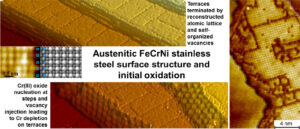Stainless Steel Surface Structure and Initial Oxidation at Nanometric and Atomic Scales. Ma, L.; Wiame, F.; Maurice, V.; Marcus, P. Applied Surface Science 2019, 494, 8–12. https://doi.org/10.1016/j.apsusc.2019.07.166.
 The durability of passivable metals and alloys is often limited by the stability of the surface oxide film, the passive film, providing self-protection against corrosion in aggressive environments. Improving this stability requires to develop a deeper understanding of the surface structure and initial surface reactivity at the nanometric or atomic scale. In this work we applied scanning tunneling microscopy to unravel the surface structure of a model stainless steel surface in the metallic state and its local modifications induced by initial reaction in dioxygen gas. The results show a rich and complex structure of the oxide-free surface with reconstructed atomic lattice and self-organized lines of surface vacancies at equilibrium. New insight is brought into the mechanisms of initial oxidation at steps and vacancy injection on terraces leading to Cr-rich oxide nuclei and locally Cr-depleted terraces, impacting the subsequent mechanism of chromium enrichment essential to the stability of the surface oxide.
The durability of passivable metals and alloys is often limited by the stability of the surface oxide film, the passive film, providing self-protection against corrosion in aggressive environments. Improving this stability requires to develop a deeper understanding of the surface structure and initial surface reactivity at the nanometric or atomic scale. In this work we applied scanning tunneling microscopy to unravel the surface structure of a model stainless steel surface in the metallic state and its local modifications induced by initial reaction in dioxygen gas. The results show a rich and complex structure of the oxide-free surface with reconstructed atomic lattice and self-organized lines of surface vacancies at equilibrium. New insight is brought into the mechanisms of initial oxidation at steps and vacancy injection on terraces leading to Cr-rich oxide nuclei and locally Cr-depleted terraces, impacting the subsequent mechanism of chromium enrichment essential to the stability of the surface oxide.
Origin of Nanoscale Heterogeneity in the Surface Oxide Film Protecting Stainless Steel against Corrosion. Ma, L.; Wiame, F.; Maurice, V.; Marcus, P. npj Materials Degradation 2019, 3 (1), 29. https://doi.org/10.1038/s41529-019-0091-4.
 Stainless steels are widely used as metal components owing to self-protection in aggressive environments, provided by an extremely thin surface oxide film enriched in chromium oxide. Yet, despite decades of research, the mechanisms distributing the chromium enrichment at small length scale are poorly understood, although it may cause loss of stability and local failure of the corrosion resistance. Here, we apply high resolution surface analysis to investigate at small time and length scales the nucleation and growth mechanisms of the surface oxide on a model stainless steel. Starting from an oxide-free surface, we report the direct observation of the oxide nucleation and local oxidation of chromium, which governs the nanoscale heterogeneity of the growing surface oxide by chromium pumping from the atomic terraces to the steps for preferential Cr(III) oxide nucleation and subsequently by segregation from the atomic planes below to grow the Cr(III) layer incompletely saturating the stainless steel surface. This work provides new insight on corrosion chemistry, by evidencing local chemical and structural defects self-generated at the nanoscale by the building process of the protective oxide barrier, and affecting the passive film stability.
Stainless steels are widely used as metal components owing to self-protection in aggressive environments, provided by an extremely thin surface oxide film enriched in chromium oxide. Yet, despite decades of research, the mechanisms distributing the chromium enrichment at small length scale are poorly understood, although it may cause loss of stability and local failure of the corrosion resistance. Here, we apply high resolution surface analysis to investigate at small time and length scales the nucleation and growth mechanisms of the surface oxide on a model stainless steel. Starting from an oxide-free surface, we report the direct observation of the oxide nucleation and local oxidation of chromium, which governs the nanoscale heterogeneity of the growing surface oxide by chromium pumping from the atomic terraces to the steps for preferential Cr(III) oxide nucleation and subsequently by segregation from the atomic planes below to grow the Cr(III) layer incompletely saturating the stainless steel surface. This work provides new insight on corrosion chemistry, by evidencing local chemical and structural defects self-generated at the nanoscale by the building process of the protective oxide barrier, and affecting the passive film stability.
XPS and ToF-SIMS Characterization of the Surface Oxides on Lean Duplex Stainless Steel – Global and Local Approaches.
Gardin, E.; Zanna, S.; Seyeux, A.; Allion-Maurer, A.; Marcus, P. Corrosion Science 2019, 155, 121–133.
https://doi.org/10.1016/j.corsci.2019.04.039.
 This work reports an innovative methodology based on the coupling of XPS and ToF-SIMS in order to study the surface oxide layer formed on austenite and ferrite phases of duplex stainless steels. The native oxide film obtained after mechanical polishing and the passive film obtained after electrochemical passivation in 0.05 M H2SO4 were investigated. Chromium and molybdenum contents were found to be higher in the oxide layer formed on ferrite phase. Nickel and nitrogen enrichments were found to be more pronounced under the oxide layer formed on austenite phase. The effect of passivation on the surface oxide layer is discussed.
This work reports an innovative methodology based on the coupling of XPS and ToF-SIMS in order to study the surface oxide layer formed on austenite and ferrite phases of duplex stainless steels. The native oxide film obtained after mechanical polishing and the passive film obtained after electrochemical passivation in 0.05 M H2SO4 were investigated. Chromium and molybdenum contents were found to be higher in the oxide layer formed on ferrite phase. Nickel and nitrogen enrichments were found to be more pronounced under the oxide layer formed on austenite phase. The effect of passivation on the surface oxide layer is discussed.
